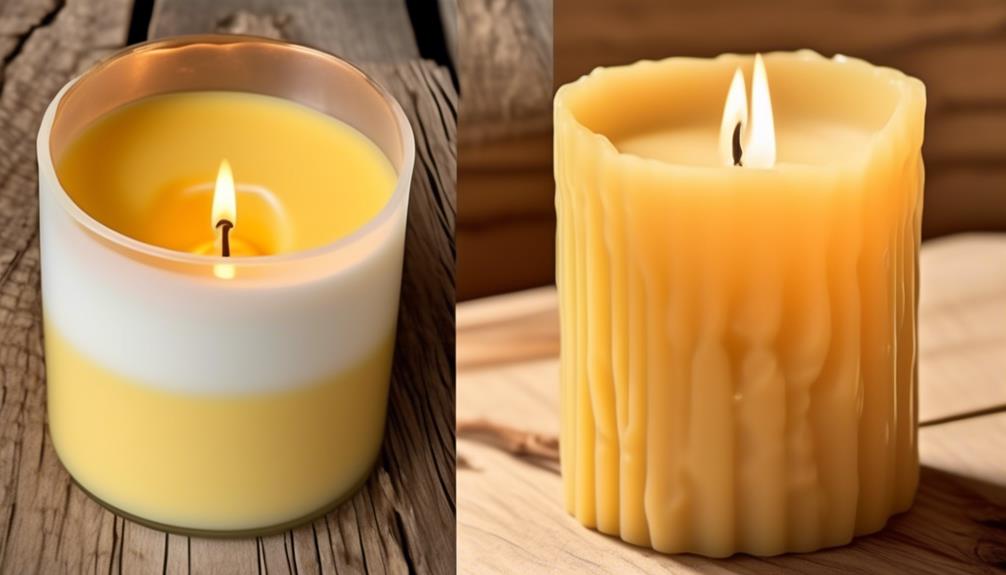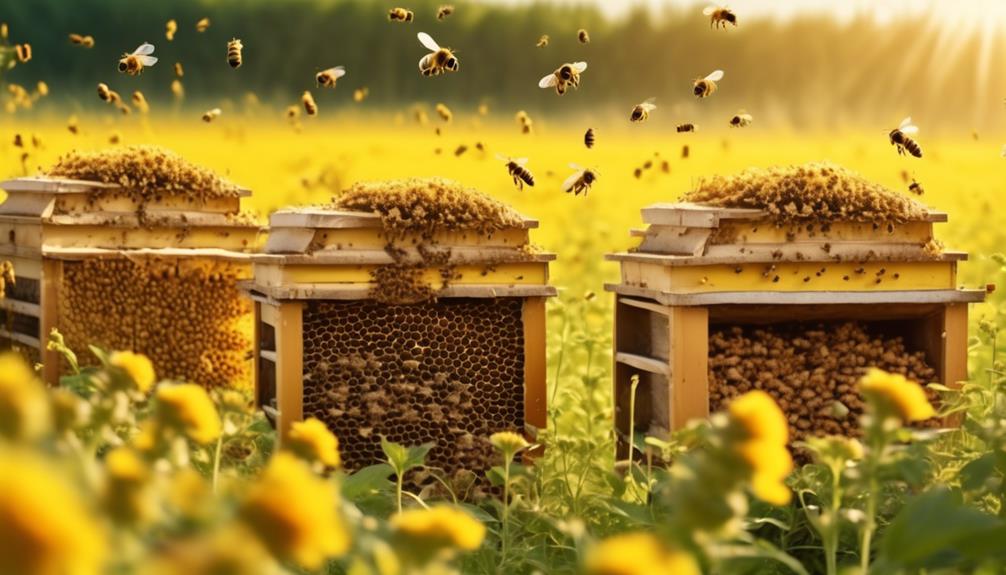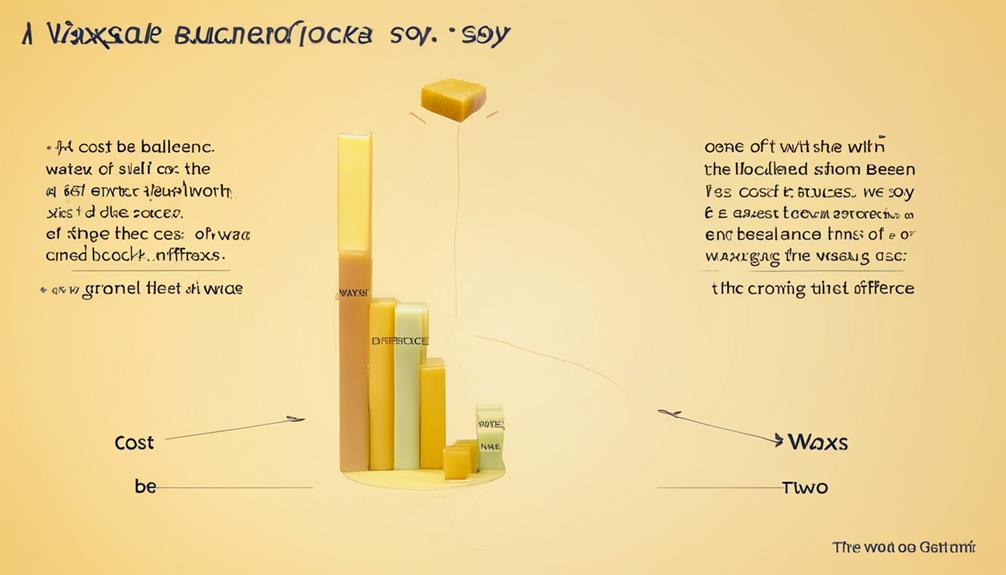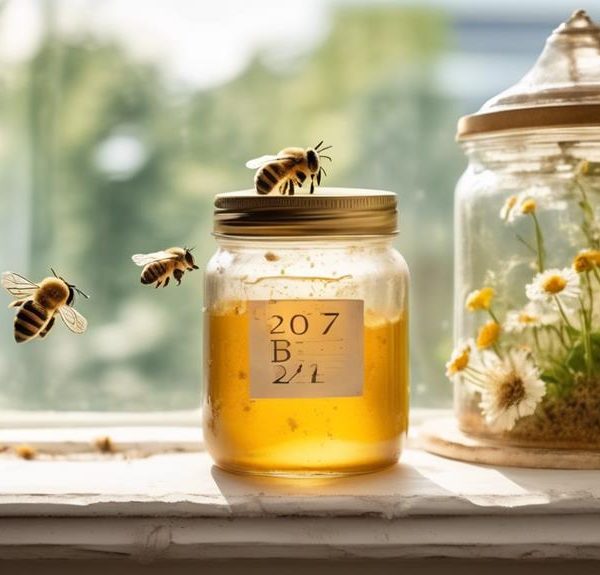Gauge the benefits of beeswax versus soy wax candles, considering environmental impact, burn time, aroma, performance, and cost.

What Is Better Beeswax or Soy Wax?
You might not be aware, but the choice between beeswax and soy wax candles goes beyond just their aesthetic appeal or scent. It's also a matter of environmental impact, burn time, performance, aroma, and cost.
While both have their merits, each type of wax presents unique advantages that might make it more appealing to you.
Stick around, and you'll find out which one might just be the best fit for your preferences and needs.
Key Takeaways
- Beeswax is a renewable and zero-waste product with a long burn time and natural scent.
- Overharvesting of beeswax can negatively impact bee populations and the environment.
- Soy wax is renewable and biodegradable, but its production involves heavy pesticide use and deforestation.
- Beeswax candles tend to be more expensive but offer a longer burn time, brighter flame, and natural scent, while soy candles are budget-friendly and provide a clean, steady burn.
Understanding Beeswax and Soy Wax

To truly grasp which is better between beeswax and soy wax, you need to first understand the unique characteristics and production processes of each.
Beeswax is a natural wax produced by honey bees. The bees secrete it to build their honeycombs, and it's later collected by beekeepers. It's then melted and filtered to remove impurities. It's renowned for its long burn time and natural, honey-like scent.
Soy wax, on the other hand, is a vegetable wax derived from soybean oil. After the beans are harvested, they're cleaned, cracked, and rolled into flakes. The oil is then extracted from these flakes and hydrogenated to convert it into wax. Soy wax is widely appreciated for its clean, soot-free burn and ability to hold fragrance well.
Both waxes have their pros and cons. Beeswax offers a longer burn time, but it's more expensive and harder to come by. Soy wax is more affordable and accessible, but it doesn't burn as long.
The choice between the two ultimately depends on your specific needs and preferences.
Environmental Impact of Both Waxes

While considering your needs and preferences in choosing between beeswax and soy wax, it's equally crucial to weigh the environmental impact of both waxes.
Beeswax, a natural byproduct of honey production, is renewable and produces minimal soot when burned. It's a zero-waste product, as every part of the bee's wax is utilized. However, it's important to ensure your beeswax is ethically sourced. Overharvesting can stress bee populations and negatively impact the environment.
On the other hand, soy wax, derived from soybean oil, is also renewable and biodegradable. It burns cleaner than paraffin, reducing soot emissions significantly. However, the production of soy wax often involves heavy pesticide use and deforestation, which can outweigh its green benefits.
Comparing Burn Time and Performance

When it comes to burn time and performance, you'll find notable differences between beeswax and soy wax.
Beeswax has the upper hand in terms of burn time. It burns slower and lasts significantly longer than its soy counterpart. This means you'll get more value from a beeswax candle, as it delivers more hours of light and heat from a single unit.
On the other hand, soy wax doesn't burn as hot as beeswax. This has a couple of advantages. Firstly, it's safer. There's less risk of burns or fires. Secondly, it's better for your candles' scent. With a cooler burn temperature, the fragrance oils aren't overheated. This allows them to disperse into your room more evenly and efficiently, providing a more consistent and pleasing aroma.
In terms of performance, both waxes perform admirably. They both burn cleanly, with minimal soot or smoke. However, beeswax has a natural, sweet scent and emits negative ions when burnt, which can help purify the air in your home.
Aromas: Beeswax Vs Soy Wax

Diving into the realm of aromas, you'll notice that beeswax and soy wax each offer unique scent profiles that can enhance your candle-burning experience. Beeswax has a natural, sweet honey-like fragrance that can fill a room without needing additional scents. It's a clean, soothing aroma that many find calming and comforting.
On the other hand, soy wax is essentially odorless, allowing for a purer scent from the added fragrances or essential oils. This feature makes soy candles an excellent choice for those who prefer strong, specific fragrances. You'll get a true-to-scent candle, with the aroma you choose standing out, unaltered by the smell of the wax itself.
However, it's worth noting that scent throw, or how well a candle's aroma fills a space, can vary between these two types of wax. Beeswax candles tend to have a subtler scent throw, while soy candles, especially those with added fragrances, can permeate a larger space.
Cost Analysis: Beeswax Versus Soy Wax

In considering the financial aspect of choosing between beeswax and soy wax, you'll find a notable disparity in their pricing. Beeswax, being a natural byproduct of honey production, tends to be more expensive. Its cost reflects the effort required to harvest and process it. On the other hand, soy wax, made from soybean oil, is significantly cheaper due to its wide availability and easier manufacturing process.
When you buy a beeswax candle, you're often paying for a longer burn time, a brighter flame, and the natural honey-like scent. However, the higher upfront cost may not be justifiable for everyone.
Soy candles are much more budget-friendly and still provide a clean, steady burn. They're also great at holding and releasing fragrance, making them a popular choice for scented candles. However, the burn time is usually shorter than beeswax candles.
In the end, your choice between beeswax and soy wax will likely come down to a balance of cost and your specific needs and preferences. If you're on a tight budget but still want a quality, eco-friendly candle, soy wax may be your best bet. If cost isn't a major concern and you value longevity and natural components, beeswax could be the way to go.
Frequently Asked Questions
What Are the Potential Allergy Concerns With Beeswax and Soy Wax?"
You might experience allergies from either beeswax or soy wax. Beeswax could trigger reactions if you're allergic to honey or pollen. Symptoms can include sneezing, coughing, or skin rashes.
Soy wax is generally safe, but if you're allergic to soy products, you might react to the wax too.
Can I Mix Beeswax and Soy Wax for Candle Making?"
Absolutely, you can mix beeswax and soy wax for candle making. It's an excellent way to combine the long burn time of beeswax with the scent-throwing capabilities of soy wax.
You'll need to experiment with ratios to find what works best for your specific needs. Remember, the melting points differ, so melt them separately before combining.
It's a fun, creative process, so don't be afraid to experiment!
Are There Any Health Benefits to Burning Beeswax or Soy Wax Candles?"
You're asking about health benefits of burning beeswax or soy wax candles.
Beeswax candles are known to purify the air by releasing negative ions, potentially reducing dust, allergens, and mold.
Soy wax candles, on the other hand, burn cleaner and longer than paraffin, with less soot. They're also made from renewable resources.
How Does the Wax Type Impact the Longevity of the Candle Scent?"
The type of wax significantly impacts the longevity of your candle's scent. Beeswax holds scent longer due to its higher melting point, allowing for a slower, longer burn.
Soy wax, on the other hand, burns cleaner and releases its scent quicker. However, it doesn't last as long.
Are Beeswax and Soy Wax Candles Safe for Pets?"
You're probably concerned about your pet's safety around candles. Both beeswax and soy wax candles are non-toxic, making them safe for pets.
However, it's the essential oils used in candles you should watch out for. Some may be harmful to pets when inhaled.
Always keep candles out of reach and ensure the room's well-ventilated. It's best to research and choose pet-friendly essential oils for your candles.
Conclusion
In conclusion, both beeswax and soy wax have their merits. Beeswax is natural, long-burning, and hypoallergenic.
Soy wax, on the other hand, is eco-friendly, affordable, and holds fragrance well.
It's not a clear-cut decision; it depends on your priorities. If you value sustainability and cost-effectiveness, choose soy wax. If you prefer a longer burn time and a natural product, go for beeswax.
The choice is yours.


